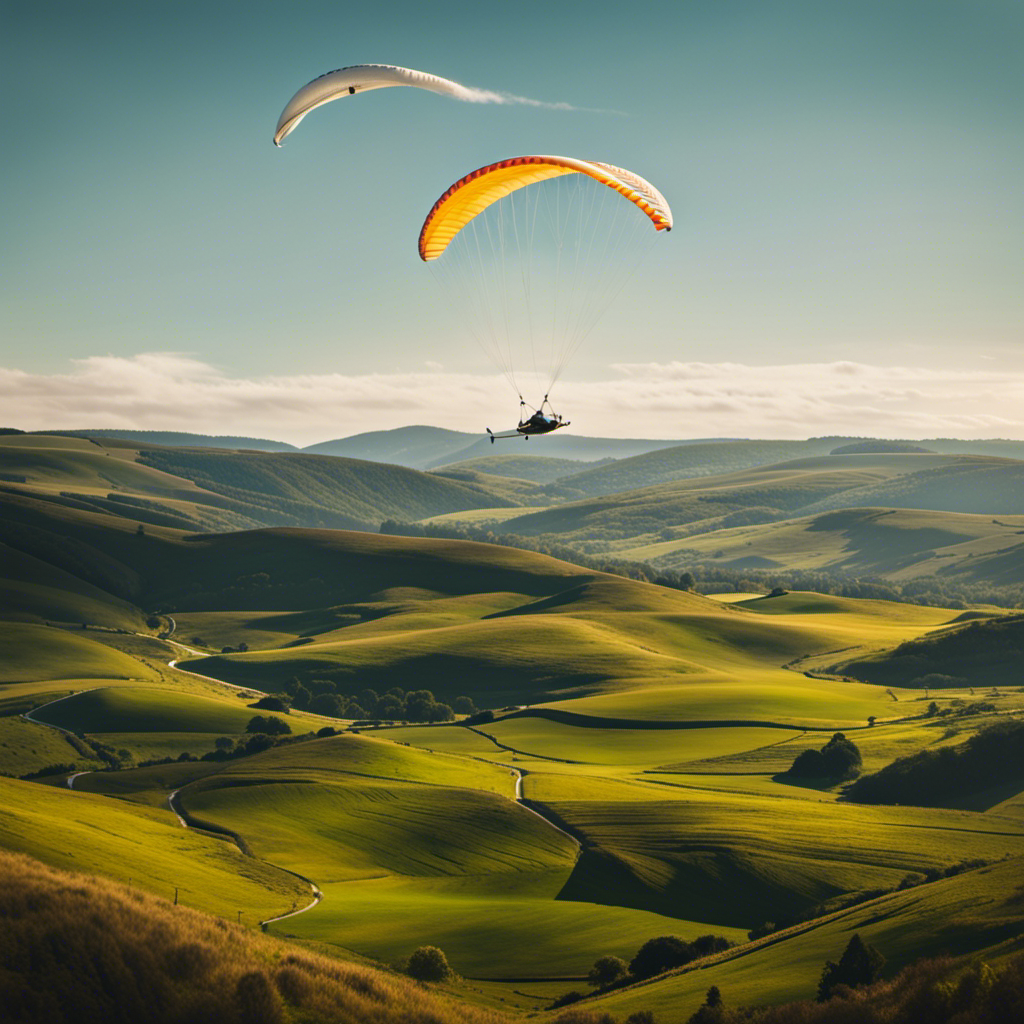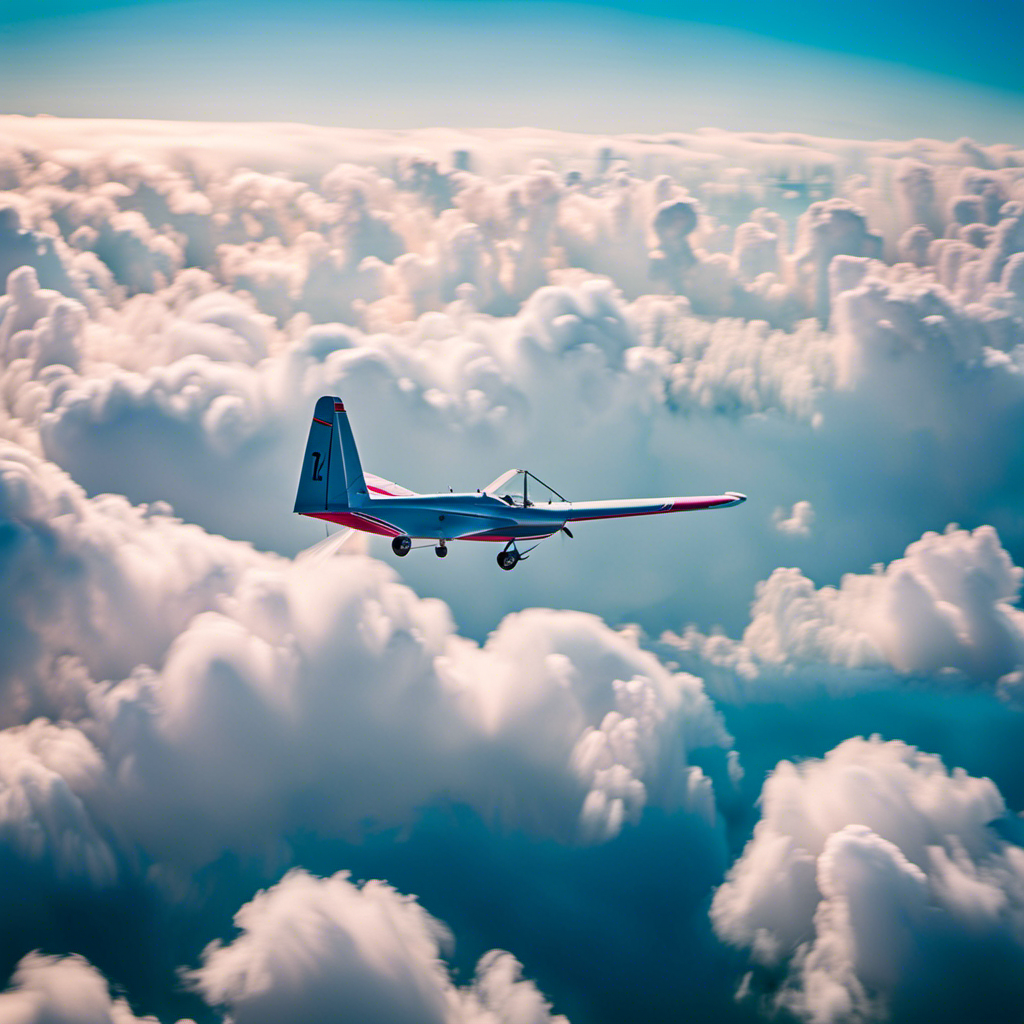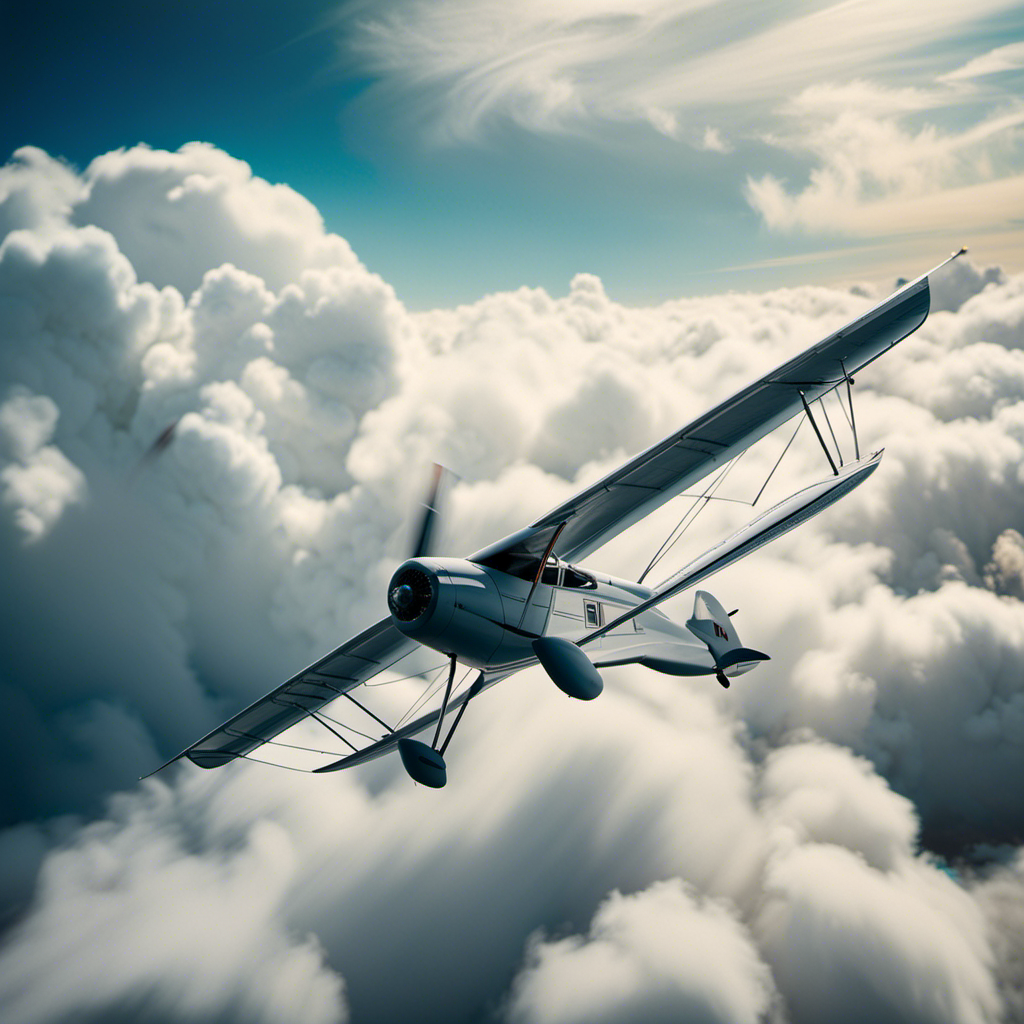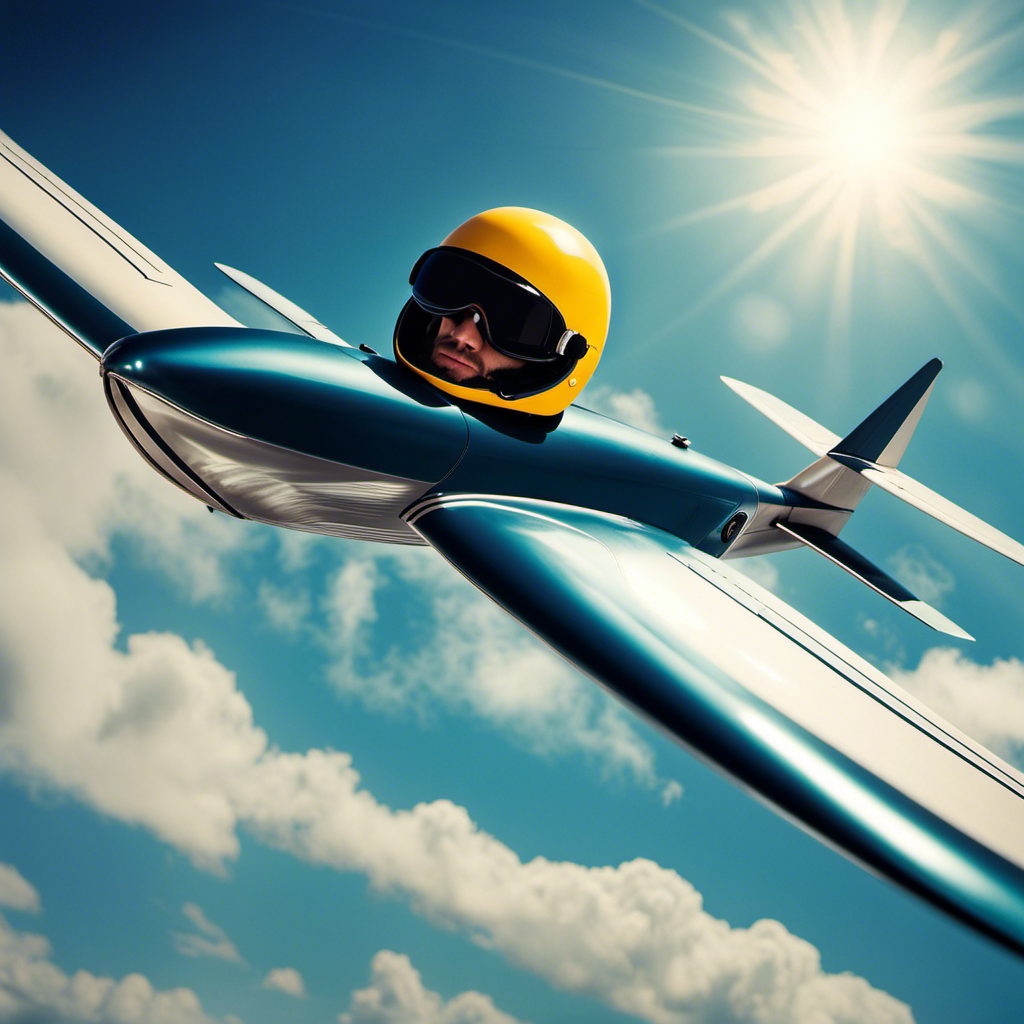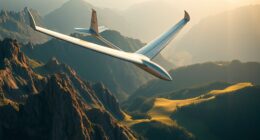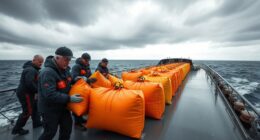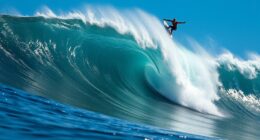Have you ever wondered if gliders, with their sleek and efficient flight through the air, can carry water like a graceful predator soaring through the sky?
In this article, I will dive into the intricate design and functionality of gliders, exploring their weight limitations, the absence of fuel tanks, and the importance of weight distribution.
Join me as we unravel the mysteries and misconceptions surrounding gliders and explore the potential for alternative methods of water transportation in these remarkable aircraft.
Key Takeaways
- Gliders have strict weight restrictions and can use water ballast systems to adjust their weight during flight.
- Adding water improves stability and performance in certain conditions, while releasing water increases maneuverability.
- Proper weight distribution is crucial for maintaining stability and control in gliders.
- Gliders rely on thermals, columns of rising warm air, to gain altitude and utilize precise flight path adjustments for altitude control.
Understanding the Design of Gliders
You’ll notice that gliders have a sleek and aerodynamic design. This design is crucial for their ability to fly efficiently and stay aloft for extended periods of time.
When it comes to glider materials, they are typically constructed using lightweight and durable materials such as carbon fiber or fiberglass. These materials help to reduce weight and increase the strength of the glider.
Another important aspect of glider design is the landing technique. Gliders are designed to land on a variety of surfaces, including grass runways and paved airstrips. The landing technique involves using the glider’s control surfaces, such as the flaps and ailerons, to slow down and control the descent. This smooth landing technique ensures a safe and controlled landing.
Now, let’s move on to discuss the function of glider wings, which play a crucial role in the glider’s flight.
The Function of Glider Wings
When flying, glider wings provide lift and stability. Gliders are designed to explore the aerodynamic principles that allow them to stay airborne without an engine. The design of glider wings plays a crucial role in achieving this.
The wings are typically long and slender, with a high aspect ratio, which means they have a large wingspan compared to their width. This shape helps to minimize drag and maximize lift. The wings also have a carefully designed airfoil shape, with a curved upper surface and a flatter lower surface. This asymmetrical shape creates a pressure difference, generating lift. Additionally, glider wings often feature winglets, which reduce drag caused by wingtip vortices.
With their efficient wing design, gliders can soar through the air with grace and precision.
Transitioning to the subsequent section about the absence of fuel tanks in gliders, it is important to note that their ability to stay aloft relies solely on the skill of the pilot and the natural forces of the atmosphere.
The Absence of Fuel Tanks in Gliders
To stay in the air, gliders rely solely on the skill of the pilot and the natural forces of the atmosphere, as they don’t have fuel tanks. This unique characteristic poses challenges for long distance glider flights, as they require alternative fuel sources to sustain their journeys.
One such source is solar power, which can be harnessed through the use of solar panels on the glider’s wings. These panels convert sunlight into electrical energy, which can be used to power various systems in the glider, such as avionics and communication devices. However, the limited surface area of glider wings presents a challenge in generating sufficient power to sustain prolonged flights.
Despite these challenges, advancements in solar technology continue to push the boundaries of glider flight, allowing for longer and more sustainable journeys.
With the absence of fuel tanks, weight limitations become a crucial factor in glider design and operation.
Weight Limitations in Gliders
It’s important to consider weight limitations in gliders, as they directly affect the performance and efficiency of the aircraft. Gliders have strict weight restrictions to ensure safe and optimal flying conditions.
One factor that contributes to the weight of a glider is water storage. Gliders do not carry fuel tanks, but they may have water ballast systems. These systems allow the pilot to adjust the glider’s weight by adding or releasing water during flight. The water is stored in dedicated tanks located in the wings.
By adding water, the pilot can increase the glider’s weight, which helps improve its stability and performance in certain conditions. On the other hand, releasing water reduces the weight, making the glider more maneuverable.
Now let’s discuss the importance of weight distribution in gliders.
The Importance of Weight Distribution in Gliders
Make sure you distribute the weight evenly in the glider to maintain stability and control during flight. Proper weight distribution is crucial for optimal glider performance. Here are some techniques to explore:
- Balance the weight between the front and back of the glider: This ensures that the glider remains stable and responsive to control inputs.
- Consider the lateral weight distribution: Evenly distributing the weight from left to right helps maintain proper balance during turns and maneuvers.
- Adjust the weight distribution based on flying conditions: Factors such as wind speed, air density, and temperature can affect glider performance. Adapting the weight distribution accordingly can enhance stability and efficiency.
By implementing these weight distribution techniques, you can maximize the glider’s performance and achieve a smooth and controlled flight experience.
Now, let’s delve into how gliders gain altitude without the use of engines.
How Gliders Gain Altitude
Gliders can gain altitude by utilizing thermals, which are columns of rising warm air. This phenomenon is crucial for glider aerodynamics as it allows gliders to stay aloft and even climb higher.
When a glider enters a thermal, the pilot must control the glider’s altitude to maximize the lift provided by the thermal. By flying in circles within the thermal, the glider can maintain its position and gradually ascend.
To achieve precise altitude control, gliders are equipped with various instruments such as variometers, which measure the rate of climb or descent. These instruments provide essential feedback to the pilot, allowing them to adjust their flight path and maintain optimal altitude.
With this understanding of glider aerodynamics and altitude control, we can now explore the safety measures that ensure a smooth and secure gliding experience.
Glider Safety Measures
To ensure your safety during gliding, remember to always check the weather conditions before taking off. Glider emergency procedures and maintenance protocols are crucial aspects of glider safety.
In the event of an emergency, pilots should be well-versed in the necessary procedures to handle various situations. These procedures may include emergency landings, stall recovery, and dealing with equipment failures.
Regular glider maintenance is essential to ensure the aircraft is in optimal condition. This includes inspecting the airframe, control surfaces, and instruments for any signs of wear or damage. Additionally, gliders should undergo regular inspections by qualified technicians to identify and address any potential issues.
By adhering to proper emergency procedures and maintenance protocols, pilots can greatly minimize the risks associated with gliding.
Transitioning into the subsequent section about gliders and their use in aviation, it is important to note that gliders play a significant role in various aviation activities.
Gliders and Their Use in Aviation
As we delve deeper into the world of gliders, it is crucial to understand the intricacies of glider aerodynamics and performance. Gliders are designed to harness the forces of nature and achieve optimal flight efficiency. Here are some key points to consider:
-
Wing Design:
-
Gliders utilize high aspect ratio wings to minimize drag and maximize lift.
-
The wing shape, such as the airfoil profile, is carefully designed to generate lift at low speeds.
-
Winglets are often incorporated to reduce induced drag and improve overall performance.
-
Weight and Balance:
-
Gliders are built with lightweight materials to enhance maneuverability and minimize drag.
-
The distribution of weight is meticulously calculated to ensure stability and control during flight.
-
Proper weight and balance management allow gliders to maintain their desired attitude and glide ratio.
-
Control Surfaces:
-
Gliders feature ailerons, elevators, and rudders that enable pilots to manipulate the aircraft’s attitude and maneuverability.
-
These control surfaces are carefully designed and positioned to optimize control authority while minimizing drag.
Understanding these aspects of glider aerodynamics and performance is essential for pilots to master the art of soaring through the skies. It sets the stage for the subsequent section, where we will explore the evolution of glider technology.
The Evolution of Glider Technology
You’ll be fascinated by how glider technology has evolved over time. From the early days of basic wooden structures to the cutting-edge designs of today, gliders have come a long way.
Historical glider models like the Lilienthal’s bird-like glider and the Wright brothers’ iconic Flyer paved the way for future advancements. These early gliders were simple and lacked sophisticated control systems. However, they laid the foundation for the development of modern gliders.
Today, glider technology incorporates lightweight materials, advanced aerodynamics, and innovative control systems. Engineers are constantly exploring future advancements, such as improved energy storage systems and more efficient wing designs. With each new generation, gliders become more capable, efficient, and safer.
Now, let’s delve into the comparison between gliders and powered aircraft.
Gliders vs. Powered Aircraft
If you want to experience the purest form of flight, gliders offer a unique and exhilarating experience compared to powered aircraft. Gliders rely solely on the forces of nature to stay airborne, making them a fascinating and challenging aircraft to fly.
When it comes to glider performance, there are several advantages that set them apart from powered aircraft:
- Efficiency: Gliders have a much higher glide ratio than powered aircraft, allowing them to travel longer distances with minimal effort.
- Silence: Without an engine, gliders produce no noise, providing a serene and peaceful flying experience.
- Cost: Gliders require no fuel or engine maintenance, making them a cost-effective option for aviation enthusiasts.
- Environmental friendliness: Gliders produce zero emissions, making them an eco-friendly choice for those concerned about their carbon footprint.
- Skill development: Flying a glider requires a high level of skill and precision, allowing pilots to refine their aviation abilities.
Transitioning into the subsequent section about gliders and their use in sports and recreation, gliders offer endless opportunities for adventure and adrenaline-fueled activities.
Gliders and Their Use in Sports and Recreation
When it comes to sports and recreation, gliders provide an exhilarating and adrenaline-fueled experience that will leave you wanting more.
While gliders are most commonly associated with soaring through the sky, they can also be utilized in water sports. Gliders in water sports offer a unique and dynamic way to explore alternative water sources and enjoy the thrill of gliding across the water’s surface.
These water gliders are designed with hydrodynamic features that allow them to efficiently glide through the water, harnessing the power of the currents and waves. Whether it’s gliding over calm lakes or riding the waves in the ocean, the use of gliders in water sports adds an exciting dimension to the world of recreational activities.
With their sleek design and expert maneuverability, gliders can navigate through the water with ease, providing an unforgettable experience for water sports enthusiasts.
Transitioning seamlessly into the role of gliders in aerodynamics research, these water gliders also play a crucial role in studying and understanding the principles of fluid dynamics.
The Role of Gliders in Aerodynamics Research
In aerodynamics research, gliders contribute valuable insights into the principles of fluid dynamics through their sleek design and expert maneuverability.
Gliders are designed to maximize efficiency, allowing them to stay aloft for extended periods with minimal power input. This efficiency is achieved through careful consideration of factors such as wing shape, aspect ratio, and airfoil design.
By studying the performance of gliders in different conditions, researchers can gain a deeper understanding of how air flows around various surfaces and shapes, leading to advancements in aviation and other industries.
Additionally, gliders’ maneuverability plays a crucial role in aerodynamics research. The ability to execute precise turns, climbs, and descents allows researchers to gather data in real-world scenarios, helping them refine models and simulations.
Transitioning to the subsequent section on glider piloting techniques, the understanding of glider efficiency and maneuverability is essential for mastering these techniques and achieving optimal performance in flight.
Glider Piloting Techniques
Glider pilots utilize various techniques to maximize efficiency and maneuverability during flight. Understanding glider aerodynamics is crucial for effective piloting. Here are some key techniques that I employ:
-
Weight shifting: By shifting my body weight, I can adjust the center of gravity and control the glider’s pitch and roll.
-
Thermal soaring: I seek out areas of warm, rising air called thermals to gain altitude and extend my flight time.
-
Speed control: Adjusting the glider’s airspeed allows me to optimize performance and navigate different flight conditions.
-
Energy management: By constantly monitoring and adjusting my altitude and airspeed, I can efficiently convert potential energy into kinetic energy.
These techniques, combined with precise glider landing techniques, ensure a safe and smooth touchdown.
Now, let’s address some common misconceptions about gliders.
Common Misconceptions About Gliders
One misconception about gliders is that they can’t stay in the air for very long, but in reality, skilled pilots can use techniques like thermal soaring to extend their flight time.
Gliders are designed to be efficient and can stay aloft for hours, taking advantage of rising air currents and thermals.
These misconceptions may stem from the fact that gliders do not have an engine and rely solely on natural forces to stay airborne. However, with the right conditions and pilot skill, gliders can soar effortlessly through the sky.
It’s important to dispel these common misconceptions and recognize the capabilities of gliders in order to fully appreciate their potential.
In the next section, we will explore alternative methods of water transportation in gliders, further expanding the capabilities of this remarkable aircraft.
Exploring Alternative Methods of Water Transportation in Gliders
After debunking the misconceptions about gliders, let’s dive into the fascinating world of alternative methods of water transportation in these aircraft. Water conservation is a crucial aspect of sustainable aviation, and finding innovative ways to store and utilize water on gliders is essential.
One approach is the implementation of specialized water storage systems that maximize efficiency and minimize weight. These systems utilize lightweight materials and advanced engineering techniques to optimize the storage capacity while maintaining aerodynamic stability.
Additionally, advanced water filtration systems are being developed to ensure the collected water remains clean and potable. These systems remove impurities and contaminants, making the water safe for consumption during extended flights.
Through these innovative solutions, gliders can not only carry water for various purposes but also contribute to the overall conservation efforts. By efficiently utilizing and managing this precious resource, we can ensure a sustainable future for aviation and our planet.
-
Sub-List 1:
-
Reduced environmental impact
-
Resource optimization
-
Sub-List 2:
-
Enhanced self-sufficiency
-
Improved sustainability
Frequently Asked Questions
Can gliders carry passengers?
Yes, gliders can carry passengers. Gliders have a limited carrying capacity due to their design and safety regulations. These regulations ensure that the glider can safely carry passengers without compromising its performance and stability in flight.
How do gliders stay in the air without an engine?
Glider flight relies on thermals and aerodynamics to stay airborne without an engine. By utilizing rising columns of warm air, gliders can gain altitude and maintain flight. This is crucial for glider competitions, where pilots aim to maximize their time in the air.
What are the weight limitations for gliders?
Weight restrictions and payload capacity are crucial considerations for gliders. These limitations determine how much weight a glider can safely carry, including passengers, cargo, and any additional equipment.
Are gliders used in commercial aviation?
Yes, gliders are used in the commercial glider industry. They offer numerous benefits in commercial aviation, such as fuel efficiency, reduced emissions, and the ability to glide silently, making them an environmentally-friendly and cost-effective choice for certain flights.
Can gliders be used for water transportation?
Amphibious gliders are designed for water sports and can be used for water transportation. With their sleek design and specialized floats, they can seamlessly transition from soaring in the sky to gliding on water surfaces.
Conclusion
In conclusion, gliders are truly remarkable aircraft that soar through the sky with grace and precision. Their design, with wings specifically crafted for efficient flight, allows them to glide effortlessly through the air.
Without the need for fuel tanks, gliders rely on the natural forces of the atmosphere to stay aloft. However, their weight limitations and the careful distribution of weight play crucial roles in their performance.
Gliders also serve as valuable tools in aerodynamics research, pushing the boundaries of flight. So, the next time you see a glider soaring through the clouds, marvel at its elegance and the fascinating world of aviation it represents.
With a heart that soars as high as the skies, Aria, affectionately known as “Skylark,” is the driving force behind Soaring Skyways. Her journey into the gliding world began as a young dreamer gazing up at the soaring birds, yearning to experience the weightlessness and freedom they embodied. With years of experience both in the cockpit and behind the scenes, Aria’s commitment to the gliding community is unwavering.

